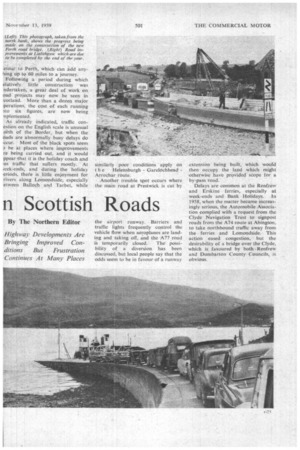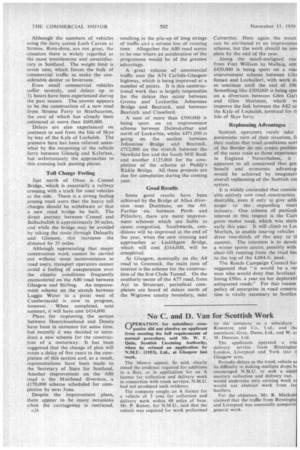Profit and La! n Scottish Roads
Page 146

Page 147

Page 148

If you've noticed an error in this article please click here to report it so we can fix it.
By The Northern Editor
MOUNTING. pressure on available road space is the changing element that faces every road operator today. Once a negligible factor, this element has, in recent years, cut deeply into operational planning. Although the impact of this trend took somewhat longer to register on the Scottish section of the road transport industry than it did south of the Border, there have always been additional difficulties, in the shape of countless ferries, in Scotland.
Fluctuations in ferry traffic, which frequently occur during the summer months, have become a problem of increasing magnitude over the past few years. But an even greater handicap in many parts is the lack of ferries, which can mean that 20 miles or more have to be covered to reach a spot only a furlong distant, as the crow flies.
Viewing Scotland as a whole, and comparing the position with that in England, the experienced transport operator would not regard the total amount of road congestion as being really serious. But on some routes conditions are as difficult as anywher in the kingdom, with countless vehicl hours lost as a result of delays.
In certain cases the road improve ments programme will iron out th difficulties in the relatively near future By far the greatest project on th Scottish schedule, at the present time is the construction of the Forth roa
bridge and its approaches. It is due t, be finished in a little over five year: time and will cost in the region o
£16m.
A body known as the " Nation2
Forth Road Bridge Committee" wa formed six years ago to press for th development of this scheme, which i of the utmost importance to th growth of industry in Fifeshire. Th
present crossing at Queensferry i subject to a weight limit of 11 tone which forces much heavy traffic t4 make an enormous detour by way o Kincardine.
There is also evidence of great fleei for a bridge across the Firth of Ta to give a direct crossing from Dundee In this way operators would avoid th use of the Dundee-Newport ferry, witl its various restrictions, or making th &tour to Perth, which can add any'ling up to 60 miles to a journey.
Following a period during which elatively little construction was ndertaken, a great deal of work on oad projects may now be seen in cotland. More than a dozen major .perations, the cost of each running
-Ito six figures, are now being riplemented.
As already indicated, traffic conestion on the English scale is unusual dith of the Border, but when the oads are abnormally busy delays do ,ccur. Most of the black spots seem 3 be at places where improvements re being carried out, and it would ppear that it is the holiday coach and ,us traffic that suffers mostly. At ieek-ends, and during the holiday ,eriods, tilde is _little enjoyment for
rivers along Lomondside, especially etween Balloch and Tarbet, while
the airport runway. Barriers and traffic lights frequently control the vehicle flow when aeroplanes are landing and taking off, and the A77 .road is temporarily closed. The possibility of a diversion has been discussed, but local people say that the odds seem to be in favour of a runway
• extension being built, which would then occupy the land which might otherwise have provided scope for a by-pass road.
Delays are common at the Renfrew and Erskine ferries, especially at week-ends and Bank Holidays. In 1958, when the matter became increasingly serious, the Automobile Association complied with a request from the Clyde Navigation Trust to signpost roads from the A74 route at Abington, to take northbound traffic away from the ferries and Lomondside. This action eased congestion, but the desirability of a bridge over the Clyde, which is favoured by both .Renfrew and Dumbarton County Councils„ is obvious. Although the numbers of vehicles using the ferry across Loch Carron at Strome, Ross-shire, are not great, the situation there is widely regarded as the most troublesome and .unsatisfactory in Scotland. The weight limit is seven tons, which forces the bull( of commercial traffic to make the considerable detour to Inverness.
Even small commercial vehicles suffer severely, and delays up to hours have been experienced during the past season. The answer appears to be the construction of a new road from Strome Ferry to Strathcarron, the cost of which has already been estimated at more than £600,000.
Delays are also experienced on journeys to and from the Isle of Skye by way of the Kyle of Lochalsh. The pressure here has been relieved somewhat by the reopening of the vehicle ferry between Glenelg and Kylerhea, but unfortunately the approaches to this crossing lack passing places.
Toll Charge Feeling
Just north of Oban is Connel Bridge, which is essentially a railway crossing with a track for road vehicles at the side. There is a strong feeling among •road users that the heavy toll charges should be withdrawn or that a new road bridge be built. The direct journey between Cannel and Ballachulish is approximately 30 miles, and while the bridge may be avoided by taking the route through Dalmally and Glencoe, this increases the distance by 35 miles.
Although appreciating that major construction work cannot be carried out without some inconvenience to road users, transport operators cannot avoid a feeling of exasperation over the chaotic conditions frequently encountered on the A80 road between Glasgow and Stirling. An improvement scheme on the stretch between Luggie Water to a point west of Cumbernauld is now in progress, however. When completed, next summer, it will have cost £434,000.
Plans for improving . the section between Dennyloanhead and Dennyhave been in existence for some time, but. recently it was decided to introduce a new scheme for the construction of a motorway. It has been suggested that the change of plan will mean a delay of five years in the completion of this section and, as a result, representations have been made to the Secretary of State for Scotland. Another improvement on the A80 road is the Muirhead diversion, a £170,000 scheme scheduled for completion by next June.
Despite the improvement plans, there appear to be many occasions when the carriageway is restricted, resultingin the pile-up of long strings of traffic and a serious loss of running time. Altogether the A80 road seems to be one where an acceleration of the programme would be of the greatest advantage.
A great volume of commercial traffic uses the A74 Carlisle-Glasgow highway, which is being improved at a number of points. It is this constructional work that is largely responsible for the delays that occur between Gretna and Lockerbie, Johnstone Bridge and Beattock, and between Beat tack and Crawford.
A sum of more than £500,000 is being spent on an improvement scheme between Dalmakethar and north of Lockerbie, whilst £471,000 is going on the section between Johnstone Bridge and Beattock, 1712,000 on the stretch between the Newfield Inn and the South Mill Bank and another £125,000 for the completion of the scheme at Paddy's Rickle Bridge. All these projects are due for completion during the coming year.
Good Results Some good results have been achieved by the Bridge of Allan diversion near Dunblane, on the A9. Farther on, between Perth and Pitlochry, there are more improvement schemes which are liable to cause congestion. Southwards, conditions will be improved at the end of the year, when the new crossing and approaches at Linlithgow Bridge, which will cost £164,000, will be completed.
At Glasgow, nominally on the A8 road to Greenock, the main item of interest is the scheme for the construction of the first Clyde Tunnel. On the southerly sector of the A77 road, from Ayr to Stranraer, periodical complaints are heard of delays north of the Wigtown county boundary, near
Cairrtryan. Here again the troub can be attributed to an improverriel scheme, but the work should be con
plete by the end of the year. .
Along the much-maligned rou from Fort William to Mallaig, son£420,000 is being spent on a ma( improvement scheme between Glet finnan and Lochailort, with work di to 'continue until the end of 196 Something like £500,000 is being spei on a diversion between Glen Gart and Glen Moriston, which wi improve the link between the A82 an the Kyle of Lochalsh, terminal for tl Isle of Skye ferry.
Replanning Advantages
Scottish operators rarely take pessimistic view of their situation, f( they realize that road conditions noni of the Border do not create problen of the same scale as those experiencE in England. Nevertheless, it apparent to all concerned that gre: benefit and economic advantagi .would be achieved by imaginati) overall replanning of the Scottish roa system.
It is widely contended that considc 'able entirely new road construction desirable, even if only to give adck scope to the _ expanding touri industry. One scheme of particuli interest in this respect is the Cain germ motor road, which was start( early this year. It will climb to Lo( Morlich, to enable touring vehicles drive two-thirds of the way to tl summit. The intention is to (level( a winter sports centre, possibly with chair-lift running from the road hez to the top of the 4,084-ft. peak.
The Roads Campaign Council hai suggested that "it would be a ras man who would deny that Scotland losing £50rn. a year on her deplorabl antiquated roads." For that reason policy of enterprise in road constru tion is vitally necessary to Scotian.
































































































































































































































































